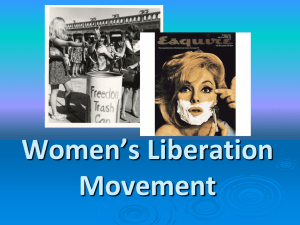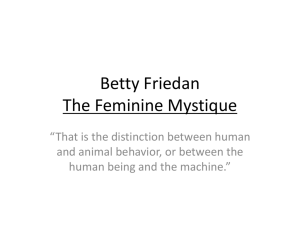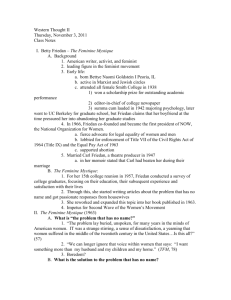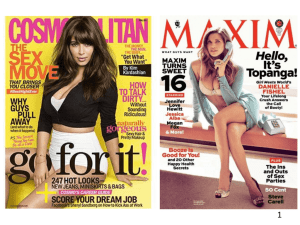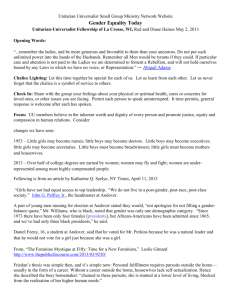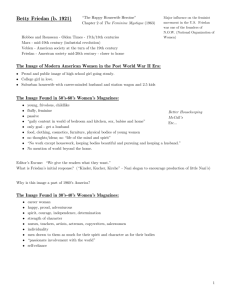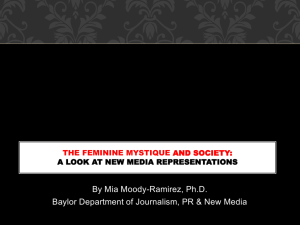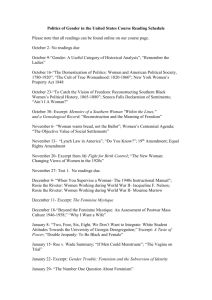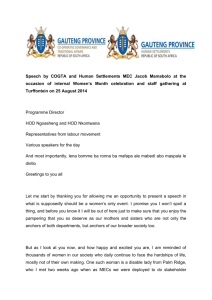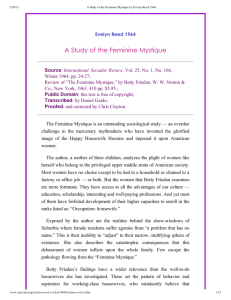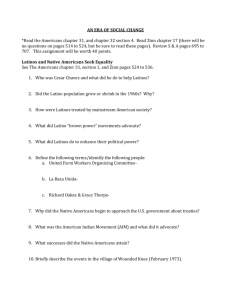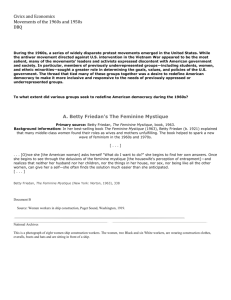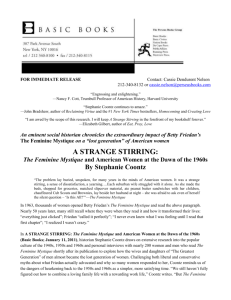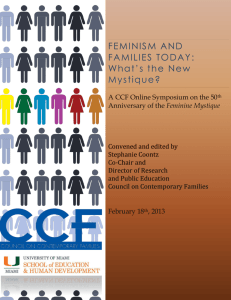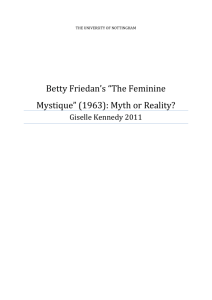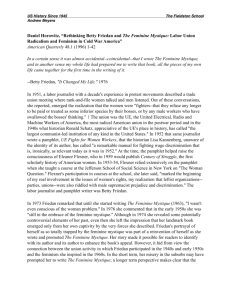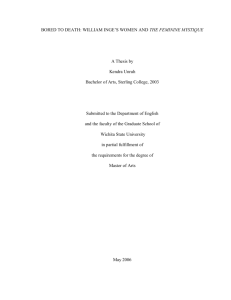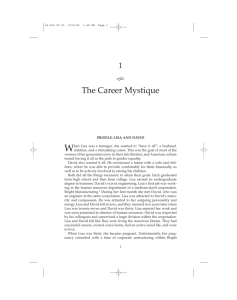Question and Answer
advertisement
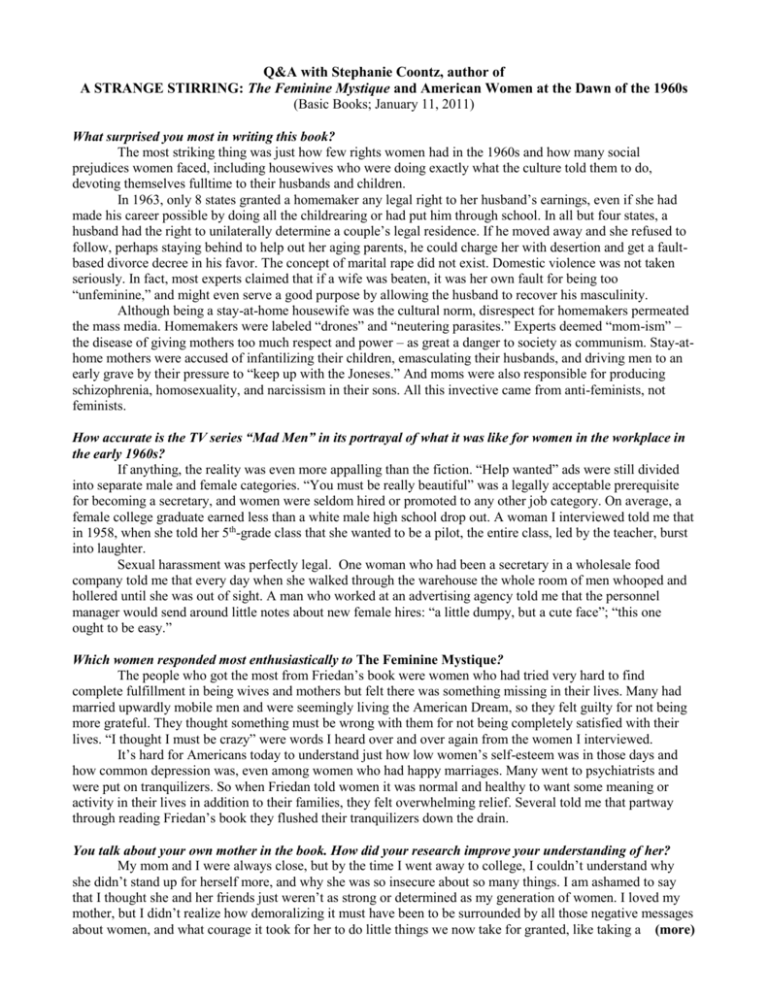
Q&A with Stephanie Coontz, author of A STRANGE STIRRING: The Feminine Mystique and American Women at the Dawn of the 1960s (Basic Books; January 11, 2011) What surprised you most in writing this book? The most striking thing was just how few rights women had in the 1960s and how many social prejudices women faced, including housewives who were doing exactly what the culture told them to do, devoting themselves fulltime to their husbands and children. In 1963, only 8 states granted a homemaker any legal right to her husband’s earnings, even if she had made his career possible by doing all the childrearing or had put him through school. In all but four states, a husband had the right to unilaterally determine a couple’s legal residence. If he moved away and she refused to follow, perhaps staying behind to help out her aging parents, he could charge her with desertion and get a faultbased divorce decree in his favor. The concept of marital rape did not exist. Domestic violence was not taken seriously. In fact, most experts claimed that if a wife was beaten, it was her own fault for being too “unfeminine,” and might even serve a good purpose by allowing the husband to recover his masculinity. Although being a stay-at-home housewife was the cultural norm, disrespect for homemakers permeated the mass media. Homemakers were labeled “drones” and “neutering parasites.” Experts deemed “mom-ism” – the disease of giving mothers too much respect and power – as great a danger to society as communism. Stay-athome mothers were accused of infantilizing their children, emasculating their husbands, and driving men to an early grave by their pressure to “keep up with the Joneses.” And moms were also responsible for producing schizophrenia, homosexuality, and narcissism in their sons. All this invective came from anti-feminists, not feminists. How accurate is the TV series “Mad Men” in its portrayal of what it was like for women in the workplace in the early 1960s? If anything, the reality was even more appalling than the fiction. “Help wanted” ads were still divided into separate male and female categories. “You must be really beautiful” was a legally acceptable prerequisite for becoming a secretary, and women were seldom hired or promoted to any other job category. On average, a female college graduate earned less than a white male high school drop out. A woman I interviewed told me that in 1958, when she told her 5th-grade class that she wanted to be a pilot, the entire class, led by the teacher, burst into laughter. Sexual harassment was perfectly legal. One woman who had been a secretary in a wholesale food company told me that every day when she walked through the warehouse the whole room of men whooped and hollered until she was out of sight. A man who worked at an advertising agency told me that the personnel manager would send around little notes about new female hires: “a little dumpy, but a cute face”; “this one ought to be easy.” Which women responded most enthusiastically to The Feminine Mystique? The people who got the most from Friedan’s book were women who had tried very hard to find complete fulfillment in being wives and mothers but felt there was something missing in their lives. Many had married upwardly mobile men and were seemingly living the American Dream, so they felt guilty for not being more grateful. They thought something must be wrong with them for not being completely satisfied with their lives. “I thought I must be crazy” were words I heard over and over again from the women I interviewed. It’s hard for Americans today to understand just how low women’s self-esteem was in those days and how common depression was, even among women who had happy marriages. Many went to psychiatrists and were put on tranquilizers. So when Friedan told women it was normal and healthy to want some meaning or activity in their lives in addition to their families, they felt overwhelming relief. Several told me that partway through reading Friedan’s book they flushed their tranquilizers down the drain. You talk about your own mother in the book. How did your research improve your understanding of her? My mom and I were always close, but by the time I went away to college, I couldn’t understand why she didn’t stand up for herself more, and why she was so insecure about so many things. I am ashamed to say that I thought she and her friends just weren’t as strong or determined as my generation of women. I loved my mother, but I didn’t realize how demoralizing it must have been to be surrounded by all those negative messages about women, and what courage it took for her to do little things we now take for granted, like taking a (more) night class, or even a part-time job. Many women I interviewed said that reading Friedan made them understand their mothers better. Some whose mothers had been moody or sharp with them said that by reading Friedan’s book they learned to forgive their mothers. Why were women who had some college education especially likely to feel these insecurities? They were a generation caught between two worlds. In the first 30 years of the 20th century, only unconventional women defied the cultural prejudices against women going to college, and such women usually aspired to a career, even if it meant missing out on marriage. As late as 1940, a 50 year-old college graduate was three times less likely to have married than other women the same age. During the 1940s and 1950s, sending a daughter to college became a status symbol for middle-class Americans, and going to college became more compatible with getting married. Parents saw college as a good way to marry their daughters to “a good provider.” But unlike today, society strongly discouraged college women from aspiring to a lifelong career, or even from taking their studies very seriously. One woman told me that when she asked her parents for help to attend graduate school, they said no, because “that would price you out of the marriage market.” Women who attended college in the 1950s often developed interests and aspirations beyond the home. But the courses they took in psychology and sociology told them that any woman who wanted to combine work and family suffered from psychological maladjustment. So when they did not want to retire from the world upon marriage, or felt regret when they did so, they experienced a deep self-doubt that is completely foreign to most contemporary educated women. Even after marriage, they second-guessed their own child-rearing more than other mothers, and constantly felt inadequate as wives. Which women were less receptive to Friedan’s book? Although Friedan had a personal history of supporting the civil rights movement and the struggles of working-class women, she very consciously targeted a white middle-class audience. Many were passionately grateful for her encouragement. But others wanted nothing more than to be fulltime homemakers and they were already stressed by the attacks on “mom-ism” that had been mounting since the early 20th century. When Friedan argued that housework was now so easy that there was no reason for a woman to make it a fulltime job, these women felt threatened and insulted. From a different perspective, many women from blue-collar families had no choice but to work, often at difficult or demeaning jobs. And if they were homemakers, their lives were hard enough that they had never entertained any illusion about finding fulfillment in baking or mopping the kitchen floor. So they didn’t have the same personal disconnect in their lives, even though – or maybe because – they had so many other pressing problems. Many critics claim that Friedan’s insistence that women need meaningful work was irrelevant to African-American women, arguing that these women would have given anything to have the “problems” of suburban wives. I disagree. In the 1950s and 1960s, even black women who could afford to be fulltime homemakers tended to work outside the home and to resist becoming completely dependent upon a man. Black leaders, not white feminists, were the first to advocate that men and women should be equal coproviders in marriage. The real tragedy of Friedan’s neglect of African-American women was that she could have used them as an example of how women could combine an identity as wife and mother with one as worker or community activist. 2011 marks the 45th anniversary of establishment of the National Organization for Women, which Friedan helped found after her book became an international bestseller. How has life changed for women since then? Women have educational and career opportunities that were unthinkable in the 1950s and early 1960s. More women graduate from college than men, and women recently pulled ahead as recipients of Ph.D.s as well. In 1972, only 3 percent of licensed attorneys were female. Today women represent one-third of all practicing attorneys and half of all law students. The stay-at-home housewife has also benefited from feminist reforms that established community property rights and gave her a legal claim to share the income her husband accumulates while she is raising the children, keeping the home, and otherwise supporting his career. As late as 1980, 30 percent of wives reported that their husbands did no housework. By the early 20th century, this had shrunk to 16 percent. Thirty-four percent of wives now say their husbands do half or (more) more of the childcare. Domestic violence has fallen dramatically over the past 45 years, although it appears that the financial strain of the recession may have produced a recent uptick. On the down side, women pay a higher price for having children than men do. One study found that more than 25 percent of women who quit work for family reasons were unable to find jobs when they returned to the job market. Others had to settle for part-time work even though they wanted fulltime. Even women who regained fulltime jobs in their own field never caught up in their salary and promotion schedule. Another study found that among women with identical resumes in all respects but one – membership in the PTA (a sign that these women had children) – the mothers were much less likely to be offered a job than the other women, were less likely to be recommended for promotion, and were held to higher performance and punctuality standards than non-mothers. The flip side of discrimination against mothers is a different kind of bias against fathers. Even when men have formal access to family-friendly policies, they are looked down upon if they use them. Because of these pressures, men are now even more likely than women to report high levels of work-family conflict. Is there still a “feminine mystique”? Not in the old sense. Few girls and young women feel there are things they cannot do or must not aspire to because they are female. In fact, the old masculine mystique may now be more constraining than the old feminine mystique. A young woman who likes activities that used to be considered masculine or dislikes “girlie” things is usually praised, or at least tolerated. But a young boy or man who enjoys activities that were traditionally associated with females is very likely to be bullied or ostracized. I think the old feminine mystique has morphed into two new mystiques. The first, which I call the “hottie mystique,” reaches its height during the teen years and the early twenties, and can seriously sidetrack young women who become obsessed with displaying their sexuality. What Betty Friedan labeled “The Sexual Sell” in one chapter of The Feminine Mystique, and the tendency to seek validation through sexuality, which Freidan described in another chapter called “The Sex Seekers,” may be more pervasive than ever. A second mystique —the “supermom mystique” —kicks in when a woman gives birth. Modern mothers spend more time with their children than moms did in the 1960s. But many women feel driven to be constantly available to their kids, making every minute a “teachable moment,” and they feel incredible guilt when they don’t live up to ever-expanding standards for involved parenting. You end your book by discussing the “career mystique” – an ideology that helps explain why workers in America put in longer hours than in any other advanced industrial country and have fewer family-friendly work policies. This is the idea that a successful career requires people to commit all their energy throughout their prime years to their jobs. The feminine mystique defined the ideal wife as having no interests or obligations outside the home. The career mystique defines the ideal employee – male or female – as having no interests or obligations outside work, because someone else is supposedly taking care of home and children. But the Ozzie and Harriet model where one parent takes care of work while another takes care of life is out of date. Today 70 percent of American children live in households where every adult is employed. There are more children being raised by single parents than by stay-at-home mothers supported by a male breadwinner. Even women who are stay-at-home mothers usually plan to rejoin the labor force in a few years. And most men are no longer content to let women experience all the joys as well as all the burdens of raising children. The Feminine Mystique asked us to imagine a world where men and women did not have to choose between partaking in meaningful, socially useful work outside the home and participating in the everyday activities of love and caregiving. Nearly half a century later, we still need reminding that this goal is in the interests of all women, men, and families. # # #
